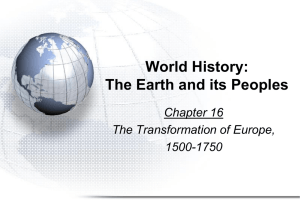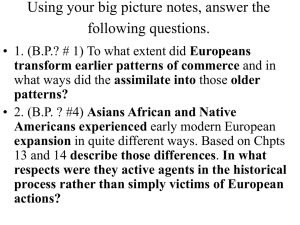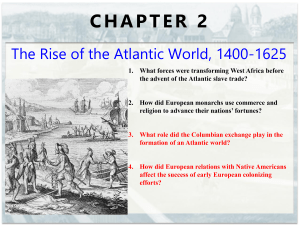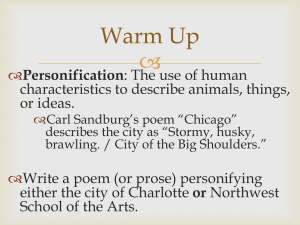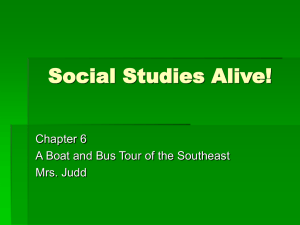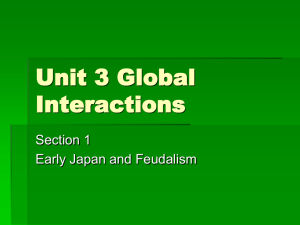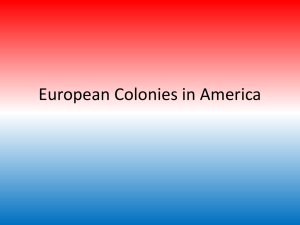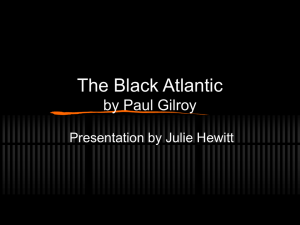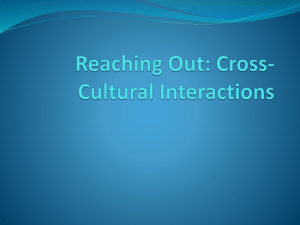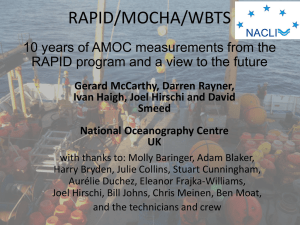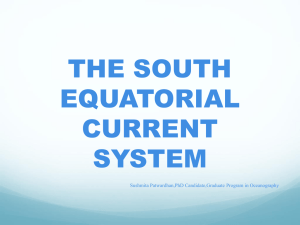Atlantic World Rise, 1400-1625: History Presentation
advertisement
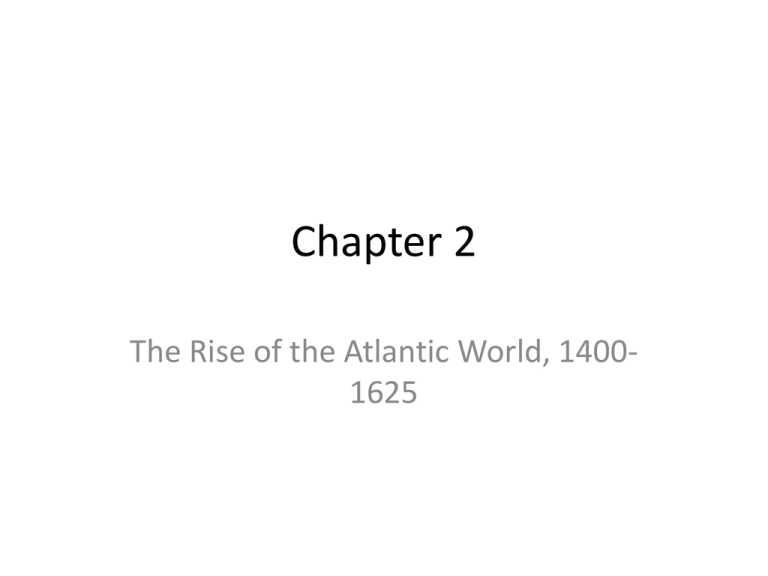
Chapter 2 The Rise of the Atlantic World, 14001625 Introduction • Oct. 12, 1492 • Columbus and crew landed on the island of San Salvador • Ended isolation of the Western Hemisphere from Europe and Asia 4 important questions • What forces were transforming West Africa before the advent of the Atlantic slave trade? • How did European monarchs use commerce and religion to advance their nations’ fortunes? 4 important questions (cont.) • What role did the Columbian exchange play in the formation of an Atlantic world? • How did relations with Native Americans affect the success of early European colonizing efforts? African and European Peoples • West Africa: Tradition and Change – Grasslands of the Sahara Dessert and east of the West African coast, kingdoms arose that rivaled those in Europe in size and wealth – 14th Century • • • • Mali Dominated entire region Lucrative trade with Europe and the Middle East Timbuktu=leading city (center of Islamic learning) West Africa: Tradition and Change (cont.) West Africa: Tradition and Change (cont.) • By 16th century Mali was conquered by Morocco • 15th century=small states on Guinea and Senegambian coast grew in population and importance • Gold was mined and traded • mid-1400’s=Portuguese arrived on the coast looking for gold and slaves West Africa: Tradition and Change (cont.) • West African leaders ranged from powerful emperors (who claimed demigod status) to heads of small states (who ruled by persuasion) • Kinship groups formed the most important unit holding people together West Africa: Tradition and Change (cont.) • Men could marry more than one woman • Allowed high-status men to establish kinship networks with other important families through their several wives • High mortality rate in West Africa=led to many marriages • Frequent famines and tropical disease epidemics • Shortage of people placed a high premium on the production of children West Africa: Tradition and Change (cont.) • • • • • Children helped with food production Most food was obtained by farming Children, men, and women all farmed Yams, rice, other grains 15th century=market economy had developed – Farmers trading surplus crops for artisan-made goods West Africa: Tradition and Change (cont.) • Religion and spirituality permeated African culture and inspired artistic endeavors • Sophisticated art and music (much of 20th century jazz is based on) • 1500’s=Islam was starting to spread beyond the kings and upper class to the common people of the grasslands • Christianity (intro. by Portuguese in 1400’s and 1500’s) made limited headway until the 19th century European Culture and Society • Europe was at height of the Renaissance (a great cultural revival) in the late 1400’s • Trying to map the world and understand natural science and astronomy • Society was hierarchical (kings at the top and peasants-75% of the people at the bottom) • Population increases in the 16th and 17th centuries made land in Europe scarce and valuable European Culture and Society (cont.) • Upper classes enclosed more of the fields and made them private property • Displaced country people drifted to the small towns (dirty, crowded, diseases) • Nuclear families were replacing kinship networks – Father ruled over wife and children as the king ruled over his subjects European Culture and Society (cont.) • New business enterprises and organizations (joint stock companies) broke the bonds of social reciprocity • Emerging entrepreneurs favored “unimpeded acquisition of wealth” and unregulated competition • They “insisted that individuals owed one another nothing but the money necessary to settle each market transaction.” Religious Upheavals • Most Europeans in 1492 were Christians – Roman Catholic Church • Headed by a pope • Administered by a hierarchy of clergy who did not marry • By 15th century, selling indulgences (blessings that would shorten the repentant sinner’s time in purgatory) for donations to the church Religious Upheavals (cont.) • Protestant Reformation – – – – – 1517 Martin Luther Denounced indulgences and other corrupt practices Broke from the Catholic Church Preached that one could not buy or earn salvation good works (or donations to the church) Religious Upheavals (cont.) • God alone decided who was saved and who was damned • Christians must have faith in his love and justice Religious Upheavals (cont.) • John Calvin • French Protestant leader • Emphasizing the doctrine of predestination (God’s foreknowledge of who was saved and who was damned) Religious Upheavals (cont.) • Counter-Reformation – Modern Roman Catholic Church was born – Aimed to clean out corruption and stimulate religious zeal – Attempting to suppress Protestantism – European countries divided into rival Protestant and Catholic camps The Reformation in England, 1533-1625 • King Henry VIII • Ruled 1509-1547 • Reformation began in England under Henry VIII • Asked the pope to annul his marriage • Pope refused The Reformation in England, 15331625 (cont.) • Henry VIII then pushed through Parliament the laws of 1533-1534, which dissolved his marriage • Also, the laws declared the king head of the Church of England (Anglican) The Reformation in England, 1533-1625 (cont.) • Religious strife continued in England for more than 100 years • Henry’s son and successor (Edward VI) leaned toward Protestantism • 1547-1553 The Reformation in England, 1533-1625 (cont.) • Mary I • “Bloody Mary” • tried to restore Catholicism • Often burned Protestants at the stake • 1553-1558 • Turned majority of English against Catholicism The Reformation in England, 1533-1625 (cont.) • • • • Elizabeth I 1558-1603 1/2 sister of Mary I Anti-Catholicism The Reformation in England, 15331625 (cont.) • The English differed on how Protestant the Church of England should be – – – – – Puritans (Calvinistic Puritans) Wanted to remove all vestiges of Catholicism Believed in predestination Felt that only the saved should belong to the church Each congregation to be self-governing and free from interference from bishops and church hierarchy The Reformation in England, 15331625 (cont.) • “Nonseparating” Puritans – Remained with the Church of England – Hoping to reform the Church of England • Separatists – Withdrew – A “pure” church had to be entirely free of Anglican “pollution” The Reformation in England, 15331625 (cont.) • Puritanism with its message of righteousness and self-discipline appealed to landowning gentry, small farmers, university-educated clergy, intellectuals, merchants, shopkeepers, and artisans The Reformation in England, 1533-1625 (cont.) • Elizabeth managed to satisfy most of English Protestants (both Puritan and Anglican) • Her successor (James I) did not • James I (1603-1625) was completely against Puritans Europe and the Atlantic World, 1400-1600 • Portugal led the way in Europe’s ocean expansion (1400-1500) – Advances in maritime technology • Caravel • Magnetic compass • Prince Henry the Navigator • Sent Portuguese sailors farther down the coast of Africa Europe and the Atlantic World, 1400-1600 (cont.) • • • • • Fought Muslims Seek opportunities for profitable trade Established a gold-processing factory at Arguin Rounded Africa’s Cape of Good Hope Developed valuable commercial links with India Europe and the Atlantic World, 1400-1600 (cont.) • These Portuguese voyages brought Europeans face to face with black-skinned Africans and an entrance into the already flourishing slave trade The “New Slavery” and Racism • Slavery existed in West Africa before the arrival of Europeans – Not based on racial differences between masters and slaves – Slaves were often eventually absorbed into the owners’ families • First Muslims from North Africa, then Europeans turned African slavery into an “intercontinental business” The “New Slavery” and Racism (cont.) • European slavers bought war captives from African slave-trading kings • This encouraged those rulers to engaged in warfare with their neighbors, using the guns they had obtained from earlier slave sales The “New Slavery” and Racism (cont.) • Nearly 12 million Africans were shipped across the Atlantic under horrific conditions to labor in the Western Hemisphere • The new slavery was based on race – Dehumanized black Africans in the eyes of white Europeans – Regarded slaves as property (not as persons) To American and Beyond, 14921522 • Christopher Columbus insisted that Europeans could reach Asia by sailing westward across the Atlantic • King and Queen of Spain were anxious to break Portugal’s monopoly of trade around Africa – They financed Columbus’ voyages To American and Beyond, 14921522 (cont.) • 1492 trip=Columbus landed on the island of Guanahani in the West Indies (he called it San Salvador) • On a subsequent voyage, he claimed and colonized for Spain the island of Hispaniola • Even after his last expedition (1498-1502), he did not realize he had discovered a new world To American and Beyond, 14921522 (cont.) • John Cabot • 1497 • Explored and claimed the north Atlantic coast for England To American and Beyond, 14921522 (cont.) • Later explorers eventually realized that a big landmass (America) blocked the way to Asia • They focused discovering a water route through or around the Americas to reach Asia To American and Beyond, 14921522 (cont.) • Balboa –Crossed the Isthmus of Panama –Reached the Pacific –1513 • Magellan –1519 –sailed around the tip of South American and reached the Philippines before being killed To American and Beyond, 14921522 (cont.) • Verrazano –Explored the coast of North America –1524 • Cartier –Sailed up the St. Lawrence –Looking for supposed Northwest passage to Asia –1534 Spain’s Conquistadores, 1492-1536 • Early Spanish explorers soon became conquerors • Columbus – Exported Indian slaves from Hispaniola – Gave grants to Spaniards to extract labor from native population Spain’s Conquistadores, 14921536 (cont.) • Hernan Cortes –1519 –Landed in Mexico –Subjugated the mighty Aztec Empire • Francisco Pizarro –1532-1536 –Conquered the Incas Spain’s Conquistadores, 1492-1536 (cont.) • Spanish conquerors were awestruck by the civilizations they encountered (size, govt., wealth, etc.) • Spanish conquerors fanned out over the Caribbean and the Americans from Mexico to Chile – Subduing and enslaving the native peoples and enriching themselves and Spain Spain’s Conquistadores, 1492-1536 (cont.) • The Indian population was nearly decimated – – – – Forced labor Warfare Starvation Alien diseases (small pox & measles) • When shortages of Indian slaves developed, the Portuguese delivered African substitutes • In 1519=Central Mexico’s population was between 13 and 25 million • By 1600=it was 700,000 The Columbian Exchange • “Columbian Exchange” or the “biological encounter” of Europe, Africa, and America had tremendous impact on the peoples, animals, and plants of all 3 areas The Columbian Exchange (cont.) • Diseases – Disease-causing microbes – Europeans and Africans brought with them – Wiped out whole tribes of Indians who lacked natural immunity – Made it easier for Europeans to conquer and colonize • Animals – Horses, cattle, sheep The Columbian Exchange (cont.) • Plants – Wheat, coffee, sugar • Food – Rice and yams from Enslaved Africans – Corn, potatoes, tobacco, turkeys • Transplanted crops and animals enriched human diets but also caused environmental change and damage to the new habitants The Columbian Exchange (cont.) • Peoples mingled – 300,000 Spanish colonists who arrived in the Americas in the 16th century were 90% male – Many took Indian wives and produced mestizo populations of Mexico and Latin America – European planters begot mulatto children with enslaved African women – Children of mixed Indian-African ancestry were also common The Columbian Exchange (cont.) • The Americas produced fabulous wealth for Spain and her colonists in the 16th century – Gold and silver from Mexican mines – sugar cane from West Indians plantations – sheep and cattle from Mexican ranches • Span’s kings became wealthy • Failed to use the wealth wisely limited the long-term benefit for their nation Footholds in North America, 15121625 • Spain’s Northern Frontier – 1500’s, looking for gold, sliver and slaves penetrated areas that would become the United States – Cabeza de Vaca and Estevanico=traveled from Florida to Texas to New Mexico – de Sato=Tampa Bay to Appalachians then to Texas – First lasting European post was established at St. Augustine Spain’s Northern Frontier (cont.) • No gold was found • Spread European diseases that wiped out most of the surviving Mississippian communities, most before they even laid eyes on the newcomers • Coronado plundered pueblos and searched for riches from the Grand Canyon to Kansas • 1598=Juan de Onate proclaimed the royal colony of New Mexico which barely survived Indian resistance and uprisings France: Colonizing Canada • Attempted to create permanent colonies – – – – 1541=St. Lawrence 1562=South Carolina 1564=Florida All failed • French carried on a lucrative fur trade with the Indians from Newfoundland to Maine and along the St. Lawrence France: Colonizing Canada (cont.) • Sensing the importance of this fur trade and determined to beat their rivals, the English and Dutch, to its profits, the French found Quebec in 1608 • First permanent French settlement in Canada France: Colonizing Canada (cont.) • Samuel de Champlain –Founded Quebec –Allied it with the local Huron, Algonquins, and Montagnais England and the Atlantic World, 1558-1603 • Late 1500’s, England took an interest in the Western Hemisphere • Queen Elizabeth encouraged English “sea dogs” (like Francis Drake) to raid Spanish treasure ships and ports in the Western Hemisphere • She split the riches with them England and the Atlantic World, 1558-1603 (cont.) • English searched for the Northwest Passage • Scoured America for gold and colony sites • 1st English settlement was in Newfoundland (1583)=it did not last • Sir Walter Raleigh – Settlement on Roanoke Island (VA) – 1584 England and the Atlantic World, 1558-1603 (cont.) • The English colonists antagonized the initially friendly Indians and failed to plant crops to feed themselves • Colonists requested more supplies be sent by English govt.=pleas went unanswered because of the Anglo-Spanish War England and the Atlantic World, 1558-1603 (cont.) • England won Anglo-Spanish War and defeated Spanish Armada in 1588 – Established the English as a major power in the Atlantic • In 1590=relief ship landed in Roanoke only it find no Englishmen – Roanoke became the “lost colony” Failure and Success in Virginia, 1603-1625 • Jamestown settlement – May 1607 – VA – 105 English landed • Virginia Company of London – Joint-stock company – Organized and financed Jamestown Failure and Success in Virginia, 1603-1625 (cont.) • The only role English government played was to grant a charter to the company giving it right to land anywhere from Cape Fear to the Hudson River Failure and Success in Virginia, 1603-1625 (cont.) • Jamestown settlers – Most were “gentlemen” – Refused to farm – Looking for gold • Failure to secure foodstuffs combined with the companies failure to adequately supply them, led to starvation and conflict with the Powhatans Failure and Success in Virginia, 1603-1625 (cont.) • During the 1st several years, majority of settlers died • Survivors were on the verge of leaving several times • The discipline and forced work imposed worked for a while; but settlers started to rebel • Captain John Smith helped to save the colony by acquiring food from Powhatan Failure and Success in Virginia, 1603-1625 (cont.) • Settler John Rolfe’s development of a tobacco palatable to Europeans gave the colony the profitable export that ensured its financial success Failure and Success in Virginia, 1603-1625 (cont.) • At first stockholders in England treated the settlers as company employees – Denied them any say in the colony’s government or ownership of any of its land • To get more people in VA and get more $$$$ – Started to award land to people who paid their own and other people’s passage to VA – Called “headrights” system Failure and Success in Virginia, 1603-1625 (cont.) • “headlights” system allowed planters who imported many indentured servants to acquire large estates • 1619=company also granted inhabitants the right to elect delegates to a legislative assembly – Beginning of representative govt. in North America Failure and Success in Virginia, 1603-1625 (cont.) • 1622=an Indian attack killed many of English settlers • 1624=charges or mismanagement of Virginia Company of London led King James I to revoke the charter – VA became a royal colony Failure and Success in Virginia, 1603-1625 (cont.) • 1624=VA had about 500 colonists – Most were indentured servants – Did not live long • Poor diet • Diseases • overwork New England Begins, 1614-1625 • • • • • • Plymouth Bay 1620 Mayflower landed 102 English Founded Plymouth http://www.history.com/m edia.do?action=clip&id=tdi h_dec18_broadband New England Begins, 1614-1625 (cont.) • Settlement was financed by some London merchants who received a charter from the Virginia Company of London to establish a colony • English Separatists who had been living in Holland to escape Anglican persecution New England Begins, 1614-1625 (cont.) • The Separatists and other non-Puritan Englishmen who joined the expedition promised to send lumber, furs, and fish back to Weston for 7 years in return for his investment New England Begins, 1614-1625 (cont.) • Winter storms blew the Mayflower off course • The colonists landed outside the boundaries of VA and the jurisdiction of its govt. New England Begins, 1614-1625 (cont.) • Mayflower Compact – Adult males of the Mayflower signed it – Created their own civil govt. and pledged to abide by its laws – http://www.historyplace.com/unitedstates/revolution/ma yflower.htm • Half the Pilgrims died during the 1st winter in Plymouth New England Begins, 1614-1625 (cont.) • Those still alive in spring of 1621 were greatly helped by 2 friendly Indians (Squanto and Samoset) –Taught them how to plant corn –Arranged treaties with neighboring tribes New England Begins, 1614-1625 (cont.) • Plymouth never grew wealthy or large • Vanguard of a mighty Puritan migration to New England in 1630’s • Proved that a self-governing farm community could survive in New England A “New Netherland” on the Hudson, 1609-1625 • 1614 – Dutch traders – Fort Nassau (near present-day Albany) • 1626 – local Munsee Indians allowed the Dutch to settle on an island at the mouth of the Hudson – Dutch named it Manhattan – Started settlement of New Amsterdam A “New Netherland” on the Hudson, 1609-1625 (cont.) • Most of the settlers lived by fur trade, competing with the French • They dealt primarily with the Iroquois (enemies of the French-backed Hurons) Conclusion • 1500’s an Atlantic world developed • Connected Europe, Africa, and the Americas • Through exploration, trade, and conquest, emerging Western European nation-states exploited for their benefit the peoples and resources of West Africa and the Americans Conclusion (cont.) • By 1600=Spanish had planted their empire firmly in Mexico, the Caribbean, and Central and South America • Indian peoples north of Mexico still held back European conquerors and colonizers Conclusion (cont.) • Between 1600 and 1625 – the Spanish made a few settlements to the north of Mexico to protect the borders of New Spain – French and Dutch established fur-trading colonies – English had begun farming on formerly Indian land in VA and Plymouth
